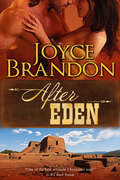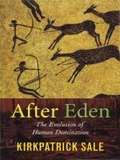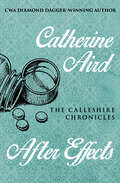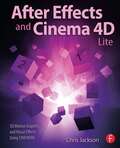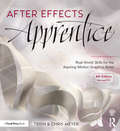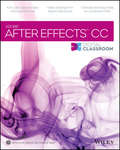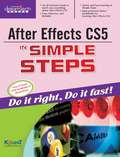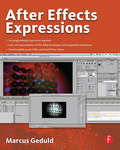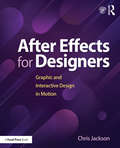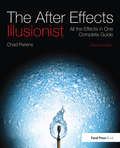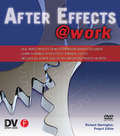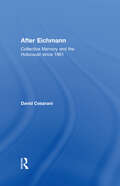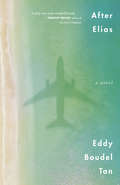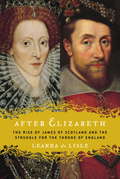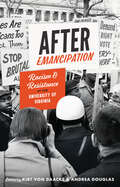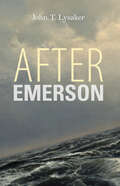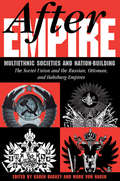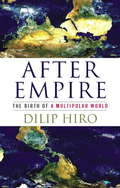- Table View
- List View
After Eden
by Joyce BrandonA dangerous love triangle sets the Arizona Territory ablaze “with all the passion, excitement and savagery that romance readers could ever hope to see” (RT Book Reviews). Teresa Garcia-Lorca grew up as the favorite daughter of the infamous Mexican revolutionary “El Gato Negro.” But when the truth of her paternity comes out, El Gato flies into a jealous rage, and Teresa must flee for her life. When she learns that her real father has died, leaving her part owner of his Tombstone ranch, her only hope for survival is to join a family she never knew. But not everyone on the ranch is happy for Teresa’s homecoming. As the spoiled daughter of her wealthy rancher father, Judy Burkhart got everything—and every man—she ever wanted. And she’s determined to add sexy ranch hand Johnny Brago to the list. But Judy’s world shatters when her father’s will names Teresa, not her, as his real daughter. And when Teresa and Johnny discover an undeniable passion, Judy will do whatever it takes to reclaim what she believes to be hers. But Teresa has never known a love like the one she’s found with Johnny. And after evading El Gato’s vicious men, she’s determined never to run from her home again. “An intricately woven story . . . a dramatic ending asserts the triumph of love.” —Publishers Weekly “This is the real West . . . one of the best westerns I have ever read.” —RT Book Reviews
After Eden: The Evolution of Human Domination
by Kirkpatrick SaleWhen did the human species turn against the planet that we depend on for survival? Human industry and consumption of resources have altered the climate, polluted the water and soil, destroyed ecosystems, and rendered many species extinct, vastly increasing the likelihood of an ecological catastrophe. How did humankind come to rule nature to such an extent? To regard the planet's resources and creatures as ours for the taking? To find ourselves on a seemingly relentless path toward ecocide?In After Eden, Kirkpatrick Sale answers these questions in a radically new way. Integrating research in paleontology, archaeology, and anthropology, he points to the beginning of big-game hunting as the origin of Homo sapiens' estrangement from the natural world. Sale contends that a new, recognizably modern human culture based on the hunting of large animals developed in Africa some 70,000 years ago in response to a fierce plunge in worldwide temperature triggered by an enormous volcanic explosion in Asia. Tracing the migration of populations and the development of hunting thousands of years forward in time, he shows that hunting became increasingly adversarial in relation to the environment as people fought over scarce prey during Europe's glacial period between 35,000 and 10,000 years ago. By the end of that era, humans' idea that they were the superior species on the planet, free to exploit other species toward their own ends, was well established.After Eden is a sobering tale, but not one without hope. Sale asserts that Homo erectus, the variation of the hominid species that preceded Homo sapiens and survived for nearly two million years, did not attempt to dominate the environment. He contends that vestiges of this more ecologically sound way of life exist today--in some tribal societies, in the central teachings of Hinduism and Buddhism, and in the core principles of the worldwide environmental movement--offering redemptive possibilities for ourselves and for the planet.
After Eden: A Short History of the World
by John Charles ChasteenTo solve the problems of the twenty-first century, historian John Charles Chasteen argues that we must first know our shared human story. In After Eden, prominent Latin American historian John Chasteen presents a concise down-to-earth, fast-paced narrative of world history, from the Big Bang to the present, animated by stories of people from all walks of life and enriched by insightful analysis and the author’s extensive world travel. To tackle today’s major problems of global inequality and environmental degradation, Chasteen argues that we must first understand our shared past, both the violent and cruel dimensions—“humanity’s inhumanity to itself”—and the aspirational ones—the creation of universal religions and ethical systems; the birth of the ideas of individual liberty and freedom; the resistance to the excesses of global capitalism; the civil rights and decolonization movements; and the environmental and social justice movements of today. For Chasteen, ultimate success hinges on our ability to recognize from our past experiences what is needed for us to live cooperatively and, most critically, the ways we educate our young people.
After Effects: The Body Politic, A Going Concern, After Effects, And Injury Time (The Calleshire Chronicles #15)
by Catherine AirdIn this mystery by CWA Diamond Dagger winner Catherine Aird, Detective Inspector C. D. Sloan investigates a case of medical malpractice that looks a bit too much like foul play Muriel Ethel Galloway passed away at home, twitching and grasping at objects only she could see. Her family mourns, sad but unsurprised that an old woman suffering from heart disease should die suddenly. But when Mrs. Galloway&’s son receives an anonymous call alerting him that his mother&’s life was put in jeopardy by her doctors, he demands action from the Calleshire Police. As world-weary detective C. D. Sloan learns, Mrs. Galloway&’s passing was just one in a string of eerily similar deaths. Dozens of elderly patients suffering from heart disease have been &“gently pushed&” toward taking part in the Cardigan Protocol, a double-blind drug trial from the powerful pharmaceutical company Gilroy&’s. Something, it seems, is very wrong. But what might have been a simple malpractice case morphs into something much more complex when the doctor in charge of the trials goes missing and the headquarters of Gilroy&’s is burgled by animal rights activists. As Detective Sloan well knows, murder is never a simple matter.
After Effects: A Memoir of Complicated Grief
by Andrea GilatsAn intensely moving and revelatory memoir of enduring and emerging from exceptional grief To grieve after a profound loss is perfectly natural and healthy. To be debilitated by grief for more than a decade, as Andrea Gilats was, is something else. In her candid, deeply moving, and ultimately helpful memoir of breaking free of death&’s relentless grip on her life, Gilats tells her story of living with prolonged, or &“complicated,&” grief and offers insight, hope, and guidance to others who suffer as she did. Thomas Dayton, Andrea Gilats&’s husband of twenty years, died at 52 after a five-month battle with cancer. In After Effects Gilats describes the desolation that followed and the slow and torturous twenty-year journey that brought her back to life. In the two years immediately following his death, Gilats wrote Tom daily letters, desperately trying to maintain the twenty-year conversation of their marriage. Excerpts from these letters reveal the depth of her despair but also the glimmer of an awakening as they also trace a different, more typical course of the grief experienced by one of Gilats's colleagues, also widowed. Gilats&’s struggle to rescue herself takes her through the temptation of suicide, the threat of deadly illness, the overwhelming challenges of work, and the rigor of learning and eventually teaching yoga, to a moment of reckoning and, finally, reconciliation to a life without her beloved partner. Her story is informed by the lessons she learned about complicated grief as a disorder that, while intensely personal, can be defined, grappled with, and overcome.Though complicated grief affects as many as one in seven of those stricken by the loss of a close loved one, it is little known outside professional circles. After Effects points toward a path of recuperation and provides solace along the way—a service and a comfort that is all the more timely and necessary in our pandemic-ravaged world of loss and isolation.
After Effects and Cinema 4D Lite: 3D Motion Graphics and Visual Effects Using CINEWARE
by Chris JacksonOne of the most exciting new features in After Effects is the integration of Cinema 4D using the CINEWARE plug-in and a free version of Cinema 4D Lite. Both provide a wide assortment of new 3D tools and options that are difficult or nearly impossible to achieve in After Effects alone. This book clearly demonstrates how the new 3D workflow bridges the two applications together to raise the design bar for motion graphics and broadcast design. Hands-on exercises teach you essential production skills including: Modeling in CINEMA 4D Lite Importing 3D models in After Effects Tracking 3D motion in After Effects Compositing with CINEWARE Using MoGraph features in CINEMA 4D Rendering and optimization techniques Additional online materials include project files and videos showcasing the techniques covered in the book. To access these materials, please see the 'eResources' tab.
After Effects Apprentice,
by Chris Meyer Trish MeyerWhether you're new to After Effects and want to get up to speed quickly, or already a user who needs to become familiar with the new features, After Effects Apprentice was created for you. With 11 core lessons plus a final project that pulls it all together, you'll learn how to tap this program's vast potential - whether you create motion graphics for network television, corporate communications, or your own projects. Fully updated to cover the major new features introduced in After Effects CS6, CS5.5, and CS5, this edition of the book presents a professional perspective on the most important features a motion graphics artist needs to master in order to use After Effects effectively. You'll learn to creatively combine layers, animate eye-catching titles, manipulate 3D space, track or rotoscope existing footage to add new elements, color key and stabilize a shot to place it in a new environment, and use effects to generate excitement or enhance the realism of a scene. Easy to follow, step-by-step instructions guide you through the features, with explanations of the "why" instead of just the "how" behind each technique. You'll learn more than just the tools; you'll learn skills that you can immediately put to work expressing your own ideas in your productions. Topics include how to: Animate, edit, layer, and composite video and still images. Manipulate keyframes and the way they interpolate to create more refined animations. Use masks, mattes, stencils and blending modes to add sophistication to your imagery. Create and animate text and shape layers Place your layers in 3D space. Use tracking and keying to create special effects, such as replacing screen displays. DVD contains: All exercise source material and project files for After Effects CS6, CS5.5, and CS5, plus 90 minutes of video tutorials.
After Effects Apprentice: Real-World Skills for the Aspiring Motion Graphics Artist (Apprentice Series)
by Chris Meyer Trish MeyerWhether you’re new to After Effects and want to get up to speed quickly, or already a user who needs to become familiar with the new features, After Effects Apprentice was created for you. With 12 core lessons including a trio of projects combining After Effects with CINEMA 4D Lite, you’ll learn how to tap this program’s vast potential – whether you create motion graphics for network television, corporate communications, or your own projects. Fully updated to cover the major new features added in After Effects CC, this edition of the book presents a professional perspective on the most important features a motion graphics artist needs to master in order to use After Effects effectively. You’ll learn to creatively combine layers; animate eye-catching titles; manipulate 3D space; color key, track or rotoscope existing footage to add new elements; and use effects to generate excitement or enhance the realism of a scene. Easy to follow, step-by-step instructions guide you through the features, with explanations of the "why" instead of just the "how" behind each technique. You’ll learn more than just the tools; you’ll learn skills that you can immediately put to work expressing your own ideas in your productions. USER LEVEL: Novice–Intermediate Topics include how to: • Animate, edit, layer, and composite a variety of media. • Manipulate keyframes and the way they interpolate to create more refined animations. • Use masks, mattes, stencils and blending modes to add sophistication to your imagery. • Create, animate, and extrude text and shape layers. • Explore 3D space, including using CINEMA 4D Lite. • Use tracking and keying to create special effects, such as replacing screen displays. A companion website at www.routledge.com/cw/meyer makes available for download all exercise source material and After Effects CC project files required to get the most out of this book.
After Effects CC Digital Classroom
by Agi Creative Team Jerron SmithEdit and apply effects for stellar visual and special effectsThis important resource is like having a personal instructor guiding you through each lesson, while you work at your own pace. Each self-paced lesson lets you discover essential skills and explore the new features and capabilities of Adobe After Effects CC (Creative Cloud). Every lesson is presented in full color with step-by-step instructions. Video tutorials and lesson files on a companion DVD were developed by the same team of professional instructors and After Effects experts who have created many of the official training titles for Adobe Systems.Combines a full-color, step-by-step instructional book along with lesson files and video training from expert instructorsWritten for After Effects CC, a leading motion graphics and visual effects program that allows users to create and deliver compelling motion graphics and visual effectsDemonstrates how to quickly get up to speed using After Effects to create and animate text, images, and video for the web, TV, and digital displaysAfter Effects CC Digital Classroom takes you from the basics through intermediate-level topics, teaching you this complex software in a clear, approachable manner. DVD and other supplementary materials are not included as part of the e-book file, but are available for download after purchase.
After Effects CS5 In Simple Steps
by Kogent Learning Solutions IncAfter Effects CS5 In Simple Steps provides a thorough, step-by-step approach to learn and master the skills required to work with After Effects CS5. The book explains the core concepts of video graphics and promises to enhance the skills required to create engaging motion graphics. In this book, you explore the new and improved features of After Effects CS5, such as Auto-keyframe mode, Refine Matte effect, and various effects and animation presets. The content presented in this book is equally helpful for the beginners as well as advanced learners. An easy to understand, stepby-step approach, supplemented with practical implementation and a plethora of real-life screenshots are some of the distinguishing features of the book. The book covers: The new and improved features of After Effects Cs5 The procedures to customize preferences to change the way After Effects CS5 works, such as changing the default undo level and enabling the Auto-Save feature The procedure to create After Effects projects and compositions, and save the project The procedure to preview media files, trim a video file, and loop an audio file The procedure to create and edit shapes using shape Tools, such as Star Tool and Pen Tool The procedure to use Path Operations, such as Repeater and Zig Zag The procedure to use paint tools to create and animate the brush stroke The procedure to work with 2D and 3D layers in After Effects CS5,including creating new layers, showing, hiding, and soloing a layer The procedure to work with animation, including adding a keyframe, editing a keyframe value The procedure to create, edit and animate masks in After Effects CS5 The procedure to work with track mattes and chroma keys The procedure to create and animate text to create typewriter effect The procedure to apply and animate effects and animation presets The procedure to add and modify audio, light, and camera in After Effects CS5 The procedure to render and export your final composition to various form
After Effects Expressions
by Marcus GeduldPut the power of Expressions to work in your animations with controls and efficiencies impossible to achieve with traditional keyframing techniques. No programming skills are required. Foundation concepts and skills orient the new designer and serve as a handy reference to the experienced one. Basics of creating expressions, variables, commands, and expression helpers precede the leap into javascript and math essentials for more advanced expressions that include randomness, physical simularions and 3D. Full color illustrations display the scripts and the resulting effects, pickwhip techniques, and sequential animations. Downloadable companion files include Quicktime movies of the demo animations, and AE project files that permit you to examine the Expressions. Extensive notes are provided to aid you in implementing the extensive library of Expressions available for your use on Adobe LiveDocs.
After Effects for Designers: Graphic and Interactive Design in Motion
by Chris JacksonAfter Effects for Designers teaches design students, artists, and web, graphic, and interactive designers how to design, develop, and deploy motion design projects using Adobe After Effects. Author Chris Jackson balances fundamental aspects of time-based design with related techniques, and explores the principles of animation; composition and layout; visual hierarchy; typography; cinematic storytelling; 3D modelling; compositing, and more. Each chapter contains unique, step-by-step project exercises that offer timesaving practical tips and hands-on design techniques, teaching readers how to effectively use the tools at their disposal in order to conceptualize and visualize creative solutions to their own motion design work. Readers will build professional-world examples in every chapter and, as a result, learn how to both design effectively using After Effects and practically apply these skills in client-based work. An accompanying companion website includes complete project files for the book's chapter exercises, and additional video tutorials.
The After Effects Illusionist: All the Effects in One Complete Guide (All The Effects In One Complete Guide Ser.)
by Chad PerkinsFirst published in 2012. Routledge is an imprint of Taylor & Francis, an informa company.
After Effects @ Work: DV Expert Series
by Richard HarringtonReal-World commercial projects presented in full color feature the work of renowned artists, Chris and Trish Meyer, Jayse Hansen, Mark Coleran, Ken Locsmandi and others. The tutorials are commercial projects that the artists created for a client budget of $10,000 or less, using only the plug-ins that come with the software. Special focus is given to the fundamental techniques that are important to novice motion graphic artists. The companion DVD contains the source files required for the reader to replicate the techniques as well as Apple QuickTime presentations of the final projects. The projects cover a wide range of practical applications including broadcast animation, big-screen film trailers, music video compositing, trade show presentations, DVD menu graphics, and cel animation with Flash.
After Eichmann: Collective Memory and Holocaust Since 1961
by David CesaraniIn 1961 Adolf Eichmann went on trial in Jerusalem for his part in the Nazi persecution and mass murder of Europe’s Jews. For the first time a judicial process focussed on the genocide against the Jews and heard Jewish witnesses to the catastrophe. The trial and the controversies it caused had a profound effect on shaping the collective memory of what became ‘the Holocaust’. This volume, a special issue of the Journal of Israeli History, brings together new research by scholars from Europe, Israel and the USA.
After Elias
by Eddy Boudel TanA modern queer tragedy about a pilot's last words, an interrupted celebration, and the fear of losing everything. “Utterly engrossing. Coen is a hero for our era, darkly struggling amid the aftershocks of loss, but doing so with dignity, humanity, and passion.” — Timothy Taylor, author of The Rule of Stephens When the airplane piloted by Elias Santos crashes one week before their wedding day, Coen Caraway loses the man he loves and the illusion of happiness he has worked so hard to create. The only thing Elias leaves behind is a recording of his final words, and even Coen is baffled by the cryptic message. Numb with grief, he takes refuge on the Mexican island that was meant to host their wedding. But as fragments of the past come to the surface in the aftermath of the tragedy, Coen is forced to question everything he thought he knew about Elias and their life together. Beneath his flawed memory lies the truth about Elias — and himself. From the damp concrete of Vancouver to the spoiled shores of Mexico, After Elias weaves the past with the present to tell a story of doubt, regret, and the fear of losing everything.
After Elizabeth: The Rise of James of Scotland and the Struggle for the Throne of England
by Leanda De LisleMany volumes have been written about the long reign of Elizabeth I. Now, for the first time, comes a brilliant new work that focuses on the critical year her reign ended, a time in which England lost its childless queen and a Machiavellian struggle ensued to find her successor.December 1602. After forty-four years on the throne, Queen Elizabeth is in decline. The formidable ruler whose motto is Semper eadem (I never change) has become a dithering old woman, missing teeth and wearing makeup half an inch thick. The kingdom has been weakened by the cost of war with Spain and the simmering discontent of both the rich and the poor. The stage has been set, at long last, for succession. But the Queen who famously never married has no heir.Elizabeth’s senior relative is James VI of Scotland, Protestant son of Elizabeth’s cousin Mary Queen of Scots. But as a foreigner and a Stuart, he is excluded from the throne under English law. The road to and beyond his coronation will be filled with conspiracy and duplicity, personal betrayals and political upheavals.Bringing history to thrilling life, Leanda de Lisle captures the time, place, and players as never before. As the Queen nears the end, we witness the scheming of her courtiers for the candidates of their choice; blood-soaked infighting among the Catholic clergy as they struggle to survive in the face of persecution; the widespread fear that civil war, invasion, or revolution will follow the monarch’s death; and the signs, portents, and ghosts that seem to mark her end. Here, too, are the surprising and, to some, dismaying results of James’s ascension: his continuation of Elizabeth’s persecution of Catholics, his desire to unite his two kingdoms into a new country called Britain, and the painful contrast between the pomp and finery of Elizabeth’s court and the begrimed quality of his own.Around the old queen and the new king, swirl a cast of unforgettable characters, including Arbella Stuart, James’s ambitious and lonely first cousin; his childish, spoiled rival for power, Sir Walter Raleigh, who plotted to overthrow the king; and Sir John Harrington, Elizabeth’s wily godson, who switched his loyalties to James long before the queen’s death. Courtesy of Leanda de Lisle’s keenly modern view of this tumultuous time, we are given intimate insights into of political power plays and psychological portraits relevant to our own era. After Elizabeth is a unique look at a pivotal year–and a dazzling debut for an exciting new historian.From the Hardcover edition.
After Elizabeth: The Rise of James of Scotland and the Struggle for the Throne of England
by Leanda De LisleMany volumes have been written about the long reign of Elizabeth I. Now, for the first time, comes a brilliant new work that focuses on the critical year her reign ended, a time in which England lost its childless queen and a Machiavellian struggle ensued to find her successor.December 1602. After forty-four years on the throne, Queen Elizabeth is in decline. The formidable ruler whose motto is Semper eadem (I never change) has become a dithering old woman, missing teeth and wearing makeup half an inch thick. The kingdom has been weakened by the cost of war with Spain and the simmering discontent of both the rich and the poor. The stage has been set, at long last, for succession. But the Queen who famously never married has no heir.Elizabeth’s senior relative is James VI of Scotland, Protestant son of Elizabeth’s cousin Mary Queen of Scots. But as a foreigner and a Stuart, he is excluded from the throne under English law. The road to and beyond his coronation will be filled with conspiracy and duplicity, personal betrayals and political upheavals.Bringing history to thrilling life, Leanda de Lisle captures the time, place, and players as never before. As the Queen nears the end, we witness the scheming of her courtiers for the candidates of their choice; blood-soaked infighting among the Catholic clergy as they struggle to survive in the face of persecution; the widespread fear that civil war, invasion, or revolution will follow the monarch’s death; and the signs, portents, and ghosts that seem to mark her end. Here, too, are the surprising and, to some, dismaying results of James’s ascension: his continuation of Elizabeth’s persecution of Catholics, his desire to unite his two kingdoms into a new country called Britain, and the painful contrast between the pomp and finery of Elizabeth’s court and the begrimed quality of his own.Around the old queen and the new king, swirl a cast of unforgettable characters, including Arbella Stuart, James’s ambitious and lonely first cousin; his childish, spoiled rival for power, Sir Walter Raleigh, who plotted to overthrow the king; and Sir John Harrington, Elizabeth’s wily godson, who switched his loyalties to James long before the queen’s death. Courtesy of Leanda de Lisle’s keenly modern view of this tumultuous time, we are given intimate insights into of political power plays and psychological portraits relevant to our own era. After Elizabeth is a unique look at a pivotal year–and a dazzling debut for an exciting new historian.From the Hardcover edition.
After Elizabeth
by Leanda De LisleA brilliant history of the succession of James I of England, and the shifting power and lethal politics that brought him to the throne. In the dawn of the 17th century when Mary Queen of Scots was dead and Elizabeth I grown old, the eyes of the English turned to Mary's son, James VI of Scotland. Leanda de Lisle's book focuses on the intense period of raised hopes and dashed expectations between Christmas 1602 and Christmas 1603, during which Elizabeth died, James was crowned and the ancient enemies of England and Scotland were ruled by one monarch for the first time. With its focus on a narrow space of time, this immensely readable history illuminates a wider period, telling in dramatic detail how the suffocating conservatism of Elizabeth's rule was replaced with that of the energetic, James. It is a story in which fortunes were made and lives lost as courtiers vied for wealth and influence. As well as painting a superb portrait of Court life, de Lisle explores the forces that shaped James's life, his separation from his mother and the violence of his Scottish kingdom; his marriage to the vivacious Anna of Denmark and the failed rebellions, government corruption and religious persecution which set the stage for James's accession to the throne of England. Drawing extensively from original sources and contemporary accounts this vivid account of the cusp of the Tudor and Stuart centuries brings to life a period of glamour and intrigue that marked the beginning of a new age.
After Emancipation: Racism and Resistance at the University of Virginia (The American South Series)
Assessing a university&’s legacy in the age of segregation This anthology reckons with the University of Virginia&’s post-emancipation history of racial exploitation. Its fifteen essays highlight the many forms of marginalization and domination at Virginia&’s once all-white flagship university to uncover the patriarchal, nativist, and elitist assumptions that shaped university culture through the late nineteenth century and well into the twentieth. Including community responses ranging from personal reflections to interviews with local leaders to poems, this accessible volume will be essential reading for anyone with ties to UVA or to Charlottesville, as well as for anyone concerned with the legacy of slavery and segregation in America&’s universities.
After Emerson (American Philosophy)
by John T. LysakerThe author of Emerson & Self-Culture shares essays covering such themes as identity, experience, ethics, poetry, philosophy, history, and race.John T. Lysaker works between and weaves together questions and replies in philosophical psychology, Emerson studies, and ethics in this book of deep existential questioning. Each essay in this atypical, philosophical book employs recurring terms, phrases, and questions that characterize our contemporary age. Setting out from the idea of where we are in an almost literal sense, Lysaker takes readers on an intellectual journey into thematic concerns and commitments of broad interest, such as the nature of self and self-experience, ethical life, poetry and philosophy, and history and race. In the manner of Emerson, Cavell, and Rorty, Lysaker’s vibrant writing is certain to have a transformative effect on American philosophy today.“An original and stimulating book, manifesting a level of reflection and existential concern of the highest order. It is intellectually and personally honest.” —Robert E. Innis, author of Susanne Langer in Focus“There is something fresh and hence refreshing in the manner in which John T. Lysaker takes up familiar topics. He shows, with both arresting details and an evolving design, how the conduct of life (to use Emerson’s expression) demands a form of thought frequently at odds with contemporary fashions and preoccupations, with institutionally entrenched approaches and all too rigidly policed discourses.” —Vincent Colapietro, author of Experience, Interpretation, and Community“Acknowledged as one of his generations premier Emerson scholars, Lysaker goes beyond his earlier work, Emerson & Self-Culture . . . [T]he writing is stimulating, vibrant, challenging, risky, and fecund. Recommended.” —D. B. Boersma, Choice
After Emily: Two Remarkable Women And The Legacy Of America's Greatest Poet
by Julie DobrowThe untold story of the extraordinary mother and daughter who brought Emily Dickinson’s genius to light. Despite Emily Dickinson’s world renown, the story of the two women most responsible for her initial posthumous publication—Mabel Loomis Todd and her daughter, Millicent Todd Bingham—has remained in the shadows of the archives. A rich and compelling portrait of women who refused to be confined by the social mores of their era, After Emily explores Mabel and Millicent’s complex bond, as well as the powerful literary legacy they shared. Mabel’s tangled relationships with the Dickinsons—including a thirteen-year extramarital relationship with Emily’s brother, Austin—roiled the small town of Amherst, Massachusetts. After Emily’s death, Mabel’s connection to the family and reputation as an intelligent, artistic, and industrious woman in her own right led her to the enormous trove of poems Emily left behind. So began the herculean task of transcribing, editing, and promoting Emily’s work, a task that would consume and complicate the lives of both Mabel and her daughter. As the popularity of the poems grew, legal issues arose between the Dickinson and Todd families, dredging up their scandals: the affair, the ownership of Emily’s poetry, and the right to define the so-called "Belle of Amherst." Utilizing hundreds of overlooked letters and diaries to weave together the stories of three unstoppable women, Julie Dobrow explores the intrigue of Emily Dickinson’s literary beginnings. After Emily sheds light on the importance of the earliest editions of Emily’s work—including the controversial editorial decisions made to introduce her singular genius to the world—and reveals the surprising impact Mabel and Millicent had on the poet we know today.
After Emma
by Sheila HockenFrom the book Jacket: Sequel to Emma and Co. Readers of Sheila Hocken's previous bestselling autobiographies (Emma & I, Emma VIP and Emma & Co) will remember her remarkable guide-dog, Emma, who inspired Sheila with a lifelong love of chocolate-brown Labradors. After Emma relates more of the hilarious (and sometimes despairing) antics of Bracken, Mocha, Buttons and Teak of Emma & Co, but it also introduces four new characters, Pip (a Colliador), Elsa (a neurotic mongrel), Katy (a black Labrador), and Katy's daughter, Psyche. Apart from its many humorous anecdotes, After Emma highlights Sheila Hocken's continuous enthusiasm and caring attitude towards the training of her dogs and she is forthright in her criticism of some methods used by other trainers. The book also movingly reveals Sheila's very real fears that an eye infection could threaten her sight once more. After Emma is the sixth delightful and heart-warming book from an author whose own experiences and reflections have won her a large and dedicated following. She won much acclaim with her first book, Emma & I, the memorable account of her special relationship with her guide-dog: "It has that rare quality motional honesty -touching and joyful" -Daily Mirror. Sheila Hocken was born in Beeston, Nottingham in 1946 into a family who were all blind or partially sighted. Emma, a chocolate-brown Labrador, gave her the freedom to travel, and was brilliantly intuitive in realising her needs. A successful operation in 1975 restored Sheila's sight, and she now lives in Stapleford, Nottingham, with her husband Don and daughter, Kerensa. After Emma is her sixth book.
After Empire: Multiethnic Societies And Nation-building: The Soviet Union And The Russian, Ottoman, And Habsburg Empires
by Karen BarkeyThe Soviet Union was hardly the first large, continuous, land-based, multinational empire to collapse in modern times. The USSR itself was, ironically, the direct result of one such demise, that of imperial Russia, which in turn was but one of several other such empires that did not survive the stresses of the times: the Austro-Hungarian Empire of the Habsburgs and the Ottoman Empire.This ambitious and important volume brings together a group of some of the most outstanding scholars in political science, history, and historical sociology to examine the causes of imperial decline and collapse. While they warn against facile comparisons, they also urge us to step back from the immediacy of current events to consider the possible significance of historical precedents.Is imperial decline inevitable, or can a kind of imperial stasis be maintained indefinitely? What role, if any, does the growth of bureaucracies needed to run large and complex political systems of this type play in economic and political stagnation? What is the balance of power" between the centre and the peripheries, between the dominant nationality and minorities? What coping mechanisms do empires tend to develop and what influence do these have? Is modernization the inexorable source of imperial decline and ultimate collapse? And what resources, including the imperial legacy, are available for political, social, and economic reconstruction in the aftermath of collapse? These are just a few of the tantalizing questions addressed by the contributors to this fascinating and timely volume.
After Empire: The Birth of a Multipolar World
by Dilip HiroAmerican corporations have to beg for capital from the cash-rich Sovereign Wealth Funds in the Persian Gulf. By invading Iraq, President George W. Bush grossly undermined American credibility in the international arena and irrevocably weakened Washington’s diplomatic clout. Together, these historic shifts have provided an opportunity for the world to move from the tutelage of the sole superpower, America, to a multi-polar global order, one where America’s moral, economic, and military leadership will be profoundly challenged. What form will this world resemble? What are the perils and promises of this new power order? InAfter Empire, Dilip Hiro provides a realistic, challenging, and nuanced look at the emerging power politics of the coming century and considers how they are going to turn our world upside-down.
